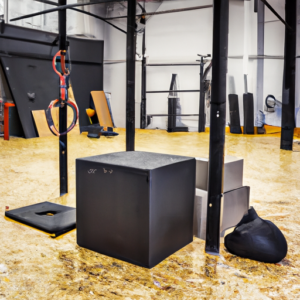Incorporating Plyometrics into Strength Training
Jumping In: Exploring the Benefits of Plyometrics
Hey there, fitness fanatics! Are you looking for a new way to amp up your strength training routine? Look no further than plyometrics. Don’t know what that is? I’ll break it down for you. Plyometrics are explosive exercises that require you to rapidly contract and then lengthen your muscles. Think jump squats, box jumps, and clap push-ups. These exercises are designed to improve your power, speed, and overall athletic performance. Trust me, the benefits are worth the sweat and burn.
Why Plyometrics Is the Best Thing to Add to My Strength Training
Let me tell you, since I started incorporating plyometrics into my strength training, I’ve seen some serious benefits. For one, it’s helped me develop explosive power – something that’s tough to accomplish with conventional weightlifting alone. Plyometrics is also great for improving balance, coordination, and agility, which means I’m not just building muscle, but I’m also becoming more adept and well-rounded athletically.
Another thing that I love about plyometrics is how effective it is at burning calories. Since the exercises are so fast-paced and high-intensity, I’m able to get my heart rate up and increase my endurance all while building muscle and strength.
But perhaps my favorite thing about plyometrics is how versatile it is. From box jumps and squat jumps to lateral hops and standing broad jumps, there are so many different exercises to choose from. Not only does this variety keep things interesting and challenging, but it also means that I’m able to target all different parts of my body in different ways.
If you’re looking to take your strength training to the next level, I highly recommend incorporating some plyometrics into your routine. Trust me, you won’t regret it.
Get Quick and Explosive with These Types of Plyometrics Exercises
If you’re looking to increase your power and explosiveness, incorporating plyometrics into your strength training routine is a great way to do it. Plyometrics involve explosive, quick movements that will engage your muscles in a way that traditional weightlifting cannot. Here are some types of plyometrics exercises to consider:

Box jumps are a classic plyometric exercise that involve jumping onto a box or bench from a standing position. To do this exercise, start with your feet shoulder-width apart and jump onto the box, landing with both feet at the same time. Step back down and repeat for several reps.
Jump squats:
Jump squats are a variation on the classic squat exercise that adds a plyometric element. Start with your feet shoulder-width apart and squat down, then jump up explosively as you rise from the squat position. Land softly and repeat for several reps.
Lateral jumps:
Lateral jumps involve jumping side to side over an obstacle, like a cone or a line on the ground. Start with your feet together and jump to one side, landing with both feet at the same time on the other side. Jump back to the first side and repeat for several reps.
Medicine ball slams:
Medicine ball slams involve lifting a medicine ball above your head and slamming it down onto the ground. This exercise helps to improve explosive power in your arms and upper body. Lift the ball above your head and slam it down onto the ground, catching it as it bounces back up. Repeat for several reps.
Remember, plyometrics exercises are intense and require proper form and technique to avoid injury. Be sure to start with a lower intensity and work your way up as you become comfortable with the movements. Always consult with a medical professional before starting a new exercise routine.
Ready to Jump In? Here’s How to Incorporate Plyometrics Into Your Strength Training
So, you’re interested in adding plyometrics to your strength training routine? Awesome! Here’s my advice on how to incorporate these explosive exercises into your workouts.
Pre-Workout Warm-Up
First things first, make sure you properly warm-up before starting any plyometrics exercises. A good warm-up can consist of some light cardio, like jumping jacks or a brisk walk, followed by dynamic stretches. Some plyometric-specific warm-up exercises could include jumping rope, ankle hops, or jumping jacks with a higher range of motion.
During the Workout
During your workout, focus on incorporating plyometrics exercises that target the muscle groups you are working on that day. For example, if you’re doing a leg workout, you could include exercises like jump squats, box jumps, and skater jumps. Remember to pace yourself – it’s best to start with a lower number of sets and reps until you feel more comfortable with each exercise.
Post-Workout Cool-Down
After you’ve completed your plyometrics exercises, it’s important to cool down properly. This can consist of some static stretching, or using a foam roller to work out any knots or tightness. Make sure to take the time to let your body properly recover before jumping back into your day.
Tips for Maximizing the Benefits of Plyometrics
If you really want to maximize the benefits of plyometrics, consider consulting with a trainer or coach who specializes in this type of training. They can help you design a safe and effective workout plan that takes into account your goals and fitness level. Additionally, make sure you have proper footwear and a safe surface to perform plyometrics exercises on – you definitely don’t want to be jumping on a slippery surface or wearing shoes without enough support!
Finally, make sure you listen to your body. Plyometrics are high-impact exercises that can put a lot of strain on your joints and muscles, especially if you’re not used to them. Take the time to properly warm-up, start slow, and don’t push yourself too hard too fast. With consistency and dedication, you’ll soon start to see the benefits of incorporating plyometrics into your strength training routine.
Tips for Maximizing the Benefits of Plyometrics
As someone who has been incorporating plyometric exercises into my strength training routine for years, I’ve learned a few tips and tricks along the way to maximize their benefits. Here are some of my top tips:
Be Smart About Your Volume and Intensity
Plyometrics can be incredibly effective, but they can also be incredibly taxing on your body. It’s important to find the right balance of volume and intensity for your individual needs. Start with a few sets of a few different exercises and gradually increase the amount and intensity as your body adapts. However, don’t push yourself too hard—overtraining is a real risk with plyometrics.
Focus on Your Form
Proper form is absolutely essential when it comes to plyometric exercises. Not only will good form help you avoid injury, but it will also ensure that you’re getting the most out of each exercise. When performing plyometrics, always prioritize quality over quantity. If you’re not able to maintain good form, consider stepping back and practicing the movement without the plyometric component before adding it back in.
Don’t Forget About Recovery
Recovery is just as important as the workout itself when it comes to optimizing the benefits of plyometrics. Make sure you’re taking time to stretch and foam roll after your workouts, and consider incorporating rest and recovery days into your routine. Adequate sleep, nutrition, and hydration are also key components of recovery.
Mix Up Your Exercises
One of the great things about plyometrics is that there are so many different exercises to choose from. Don’t get stuck in a rut doing the same handful of movements week after week. Mixing up your exercises not only helps keep things interesting, but it also ensures that your body doesn’t get too accustomed to any one movement pattern.
Listen to Your Body
Finally, it’s important to always listen to your body when it comes to plyometrics. As I mentioned earlier, these exercises can be incredibly intense, so it’s important to pay attention to how your body is feeling. If something doesn’t feel right, don’t push through the pain. Take a break, adjust your form, or decrease the intensity as needed.
By following these tips, you’ll be able to maximize the benefits of plyometric exercises and take your strength training to the next level. Good luck!
Wrappin’ It Up: Conclusion
And there you have it, folks! Plyometrics can be an excellent addition to any strength training regimen. With explosive movements and a focus on power, plyometrics can help increase your overall athleticism and improve your performance in many sports. But don’t just take my word for it – try it for yourself!Remember, when incorporating plyometrics into your workouts, it’s important to start slowly and progress gradually. Make sure to warm up properly before jumping into any explosive movements, and always use proper form to avoid injury.To maximize the benefits of plyometrics, be sure to vary your exercises and incorporate them into different parts of your workout. And don’t forget to give yourself enough rest and recovery time between workouts to avoid overtraining.So go ahead, give plyometrics a try and see how it can take your strength training to the next level! But as always, listen to your body and consult with a trainer or healthcare professional if you have any questions or concerns. Happy jumping!
Strength Training Plyometrics FAQ
Should I do plyometrics before or after strength training?
So, you want to know whether you should do plyometrics before or after strength training? Well, here’s my two cents on the matter. Personally, I think it really depends on your goals and what you’re trying to achieve. If you’re looking to improve your explosive power and speed, incorporating plyometrics prior to your strength training may be more beneficial. This is because plyometrics require a lot of energy and focus, and if you’re fatigued from your strength training, you won’t be able to perform them at your best. However, if your main goal is to increase your overall strength and muscle mass, it might be better to save plyometrics for later in your workout. That way, your muscles will be warmed up and primed for explosive movements, and you won’t run the risk of injuring yourself during the plyometric exercises. Of course, there are pros and cons to both approaches, and it ultimately comes down to what works best for you and your body. Some people even alternate between the two, doing plyometrics before and after their strength training on different days. The key is to listen to your body and do what feels right. And remember, safety always comes first!
Do you train plyometrics and strength the same day?
Well, it really depends on your fitness goals and personal preference. For example, if you’re looking to improve your power and explosiveness, then combining plyometrics and strength training in the same workout could be beneficial. However, if you’re trying to focus on building maximum strength and endurance, it might be better to separate them into different training sessions. Personally, I like to incorporate plyometrics into my strength training by doing them as part of my warm-up. This helps to activate my muscles and get me ready for the heavier lifting. I’ll typically start with some dynamic stretching and mobility work, then move on to explosive exercises like box jumps or medicine ball slams. After that, I’ll move into my regular strength training routine, alternating between upper body and lower body exercises.Another option is to dedicate a separate day to plyometrics and use it as a form of active recovery. This can be a great way to give your body a break from heavy lifting while still working on your speed and power. Just make sure that you’re not overdoing it, as plyometrics can be quite taxing on your joints and connective tissue if you’re not careful.Overall, the key is to listen to your body and adjust your training accordingly. If you feel like you’re not recovering well or are experiencing pain or discomfort, it might be time to dial back on the plyometrics or incorporate some additional rest and recovery practices. And as always, make sure to consult with a qualified fitness professional before implementing any new training strategies.
How can you use plyometric in your workout routine?
Okay, I’ll give it a go! First off, let me say that incorporating plyometric exercises into your strength training routine is a fantastic way to improve your explosive power and athleticism. Here are some tips on how to do it effectively:- Start with the basics: Plyometric exercises involve explosive, high-intensity movements like box jumps or jump squats. If you’re new to this kind of training, start with basic drills like jumping jacks or quick bounds to get your body accustomed to the movements.- Warm up and cool down properly: Plyometrics are intense, so it’s important to make sure you’re properly warmed up before you start. This could include some light cardio, dynamic stretching, and mobility drills. After your workout, take some time to cool down with static stretches or foam rolling to help prevent injury and reduce muscle soreness.- Be mindful of your form: Because these exercises are so explosive, it’s crucial to maintain proper form throughout each movement. Keep your core engaged, land with soft knees, and try to land as softly and as quietly as possible.- Incorporate plyos strategically: You don’t want to overdo it with plyometrics, especially if you’re already doing other forms of high-intensity training like CrossFit or HIIT. Consider adding one or two plyometric exercises to the beginning or end of your strength training sessions to give you that extra boost of power.- Mix it up: Plyometrics can be done with just your bodyweight, or you can add in equipment like resistance bands, medicine balls, or agility ladders to make it more challenging. Don’t be afraid to mix up your routine and try new things.Remember, plyometrics can be a fun and effective way to take your strength training to the next level. Just be sure to start slow, focus on form, and listen to your body to avoid injury. Good luck!






